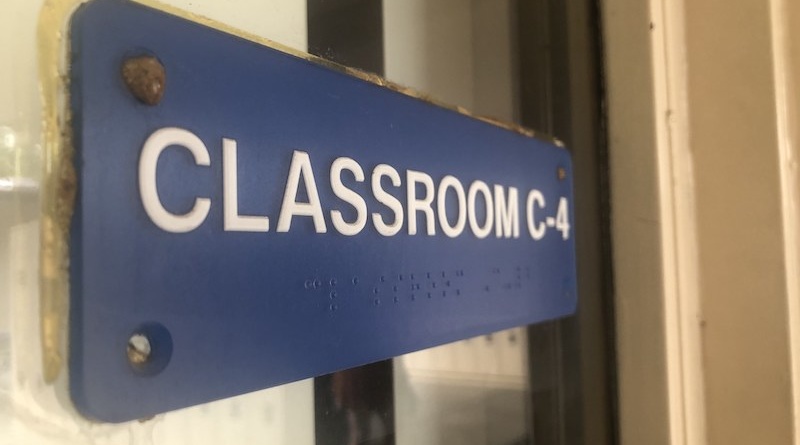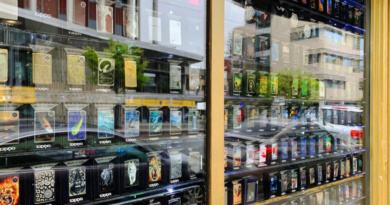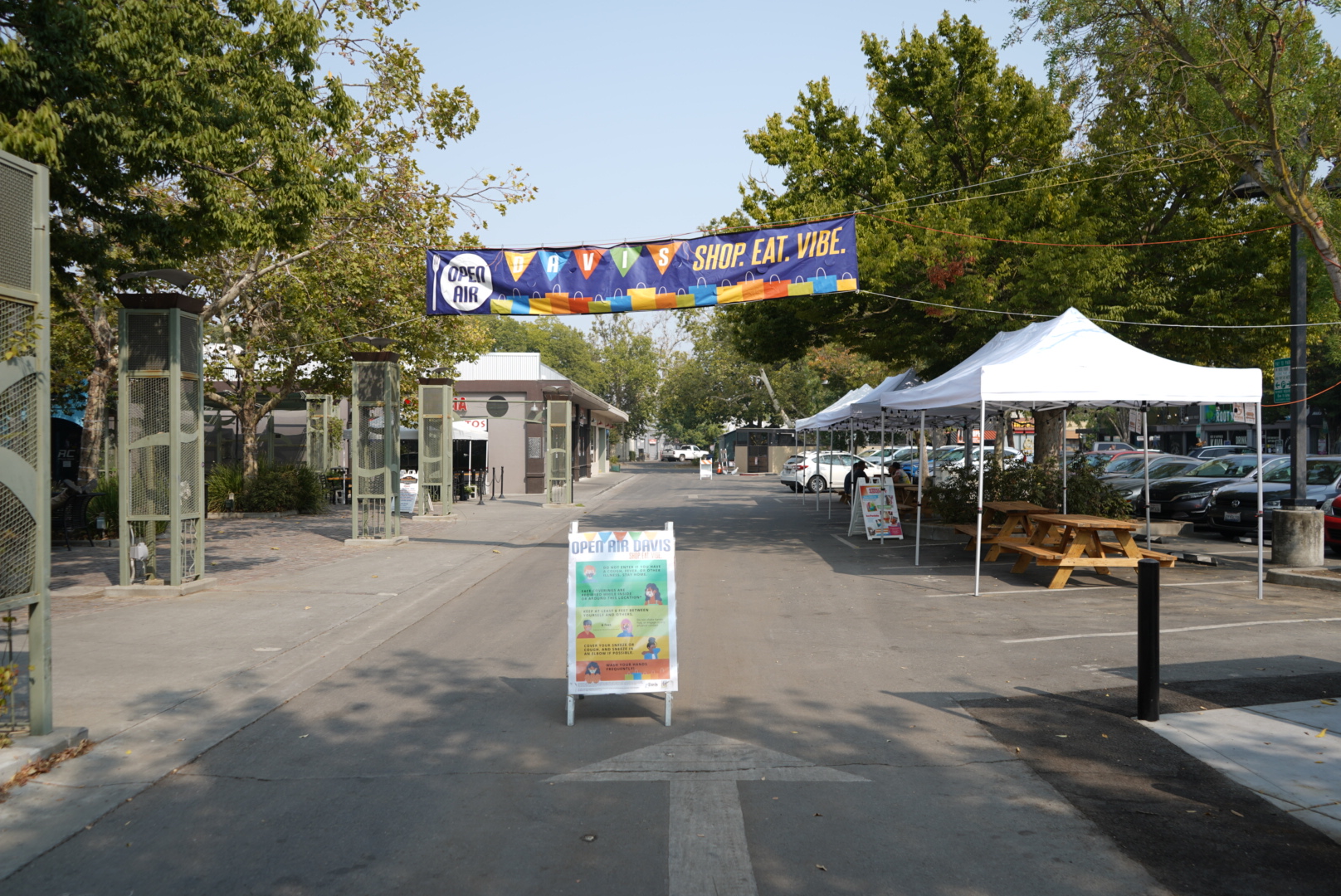Special education students explore possibility of in-person instruction
PHOTO: While the special education classroom remains locked and empty, the first steps of in-person instruction began on Oct. 12.
By Caroline Chilcott,
BlueDevilHUB.com Staff–
While distance learning has been challenging for many Davis Joint Unified School District students, families with children in the special education program are among those most affected. Without the in-person support of special education staff and resources, the need to return to campus is critical for many of these students.
Trista Pandeleos’s daughter, Olivia Pandeleos, is in the special education program at Holmes Junior High. Trista has faced many difficulties due to the lack of one-on-one teacher and paraeducator support ninth grader Olivia previously received.
“Unfortunately, I think many special education students are at a considerable disadvantage when it comes to online learning. The services they typically receive in person are not as accessible and/or are detrimentally limited in a virtual world,” Trista said.
Many students who are in special education are dependent on visual input and the physical presence of a teacher or therapist to support their learning.
Paola Franceschi is the parent of a junior at Davis High who is in special education. Franceschi has learned that too much screen time can negatively impact her son’s behavior, and families with similar situations have witnessed the same effects.
“I recognized long ago that too much screen time affected my son’s behavior in a negative way. Now I have no choice but to allow him to be in front of a screen for four to five hours a day or more,” Franceschi said.
Students who had previously relied on paraeducator support in the classroom now have to communicate with them online. As a result of distance learning, paraeducators’ roles have shifted.
“He has a paraeducator that checks in with him in one class. It is helpful, but it’s definitely not the same as having someone work with him one-on-one, in person. Last year he had a para in every single class for the duration of the class and got far more attention,” Franceschi said.
This virtual method of academic support creates a barrier that, for some special education students, is near impossible to break. For instance, there are students who have difficulty speaking, seeing, hearing or focusing, have physical disabilities that limit movement, or are academically behind their peers in many subjects. For these special education students and their families, distance learning can be even more challenging to access.
“When you have a student who struggles to communicate in person, imagine trying to articulate what you need help with or what material you didn't understand in class over a computer screen,” Trista said.
Special education students often struggle when communicating with others and can be socially isolated from their peers — an issue that distance learning magnifies.
“When you take away in person school, she has no models for social cues and behaviors, and she has no one to observe or practice with,” Trista said.
DHS epecial education teacher Christopher Learned helps his students cope with the social isolation distance learning creates through clubs and other activities.
“Everyone is facing individual challenges during this time and it is more important than ever to support each other,” Learned said.
Special education students’ parents report being forced to take on additional tasks out of necessity. Snow Hernandez, the Inclusion Specialist at Emerson Junior High, explains how her students' parents have had to take on new roles due to this online format.
“Right now, some aspects of special education distance learning are like a game of telephone where the teacher has to explain to the parent so the parent can help their student,” Hernandez said.
For Franceschi, this task is incredibly tedious and time-consuming.
“I often have to sit with him during class. I have to check Canvas daily. He is not able to organize his assignments at all on his own. He will not work on any school work without an adult helping him,” Franceschi said.
Once Franceschi and her husband realized the difficulties they were going to face with their son and distance learning, they decided to hire additional help. “He gets too irritated with his dad and me, so we have had to hire a tutor four days a week to work with him. We are fortunate that we can afford it. Many families cannot,” Franceschi said.
“Now that we know more and can do things safely and we know how much our special needs students and families are suffering, I definitely think we can proceed with some in person learning,” Franceschi said.
This idea of limited in person instruction for some special education students may become a reality relatively soon. With the movement of Yolo County to the Red Tier risk level for COVID-19, DJUSD entered phase two of their Return to Campus Plan.
“Probably not too many [special education assessments] — if any — will be happening necessarily right on [Oct. 12], but during that week we are doing in person special education assessments at four different school sites: DHS, Valley Oak, Birch Lane and Holmes,” said Laura Juanitas, the Associate Superintendent of Student Support Services. “We’ve got four rooms at each school site, and psychologists, nurses and other specialists who have to be part of the assessment will be scheduling people to come in to do the assessments.”
After these assessments take place, the next steps of stage two will begin.
“The plan then, pretty soon afterwards, is to start providing specialized individualized education plan (IEP) services on campus for students who get speech therapy, physical therapy or occupational therapy by level of service or age,” Juanitas said. “Then the third step, which will happen six to eight weeks out from now, would be having small cohorts of students who need to be on campus to receive their education.”
While Hernandez understands why the district initially decided to proceed with distance learning, she feels it is time for her students to return to the classroom.
“Most special education teachers in our district aren’t currently prepared to thrive in a virtual classroom the way they are in person,” Hernandez said.
Many special education students' parents are excited about the possibility of returning to in person school.
“My son needs human interaction. Everything in his life has been converted to a Zoom meeting. Already, as a kid with autism who has difficulty with social skills and friendship, his activities with other kids were very limited. Now they are practically nonexistent,” Francheschi said.
Martha Ozonoff is the parent of Jesse Krause, who is in ninth grade at Holmes Junior High.
“Accessing services is another issue for special needs families — although speech works okay over Zoom, occupational therapy and physical therapy are more difficult, often requiring a parent’s help to be successful,” Ozonoff said.
In addition to the academic benefits of in person school, Ozonoff elaborates upon the numerous social opportunities Krause is missing.
“Of course, school is more than just school — it’s where all students see their friends and have fun together. This is especially important for kids with special needs, who might not have hangouts outside of school — or be on social media or text and call friends. Without in person learning, that social aspect is really missing and it’s a shame,” Ozonoff said.
“I miss being with my friends, riding my bike to school and seeing my teachers,” Krause said.
However, for Olivia, returning to in person school may not be a possibility for now.
“Olivia has a seizure disorder and if her immune system is compromised by COVID-19, she may begin having difficulty controlling seizure clusters that may cause irreparable harm or setbacks. It is a heartbreaking dilemma of wanting what is socially and academically best for your child, but knowing that this may compromise her physical health,” Trista said.
“I don’t want to be online anymore. Distance learning is hard for me, so I want to go back. I miss getting to go from class to class, playing fireball, doing spirit days, lunches at lunchtime, and getting to see the kids in my classes,” Olivia said.




